[Japan International Cooperation Agency] [Thursday, Nov 20, 2014]
Faisalabad, Pakistan, Curbs Chronic Flood Damage Using Pumps Provided by Japan
A government agency in Faisalabad, Pakistan, formally took ownership of pumps and other flood mitigation equipment provided by Japan in a ceremony in October.
The city, which with a population of some 3.5 million is the third largest in Pakistan, is chronically afflicted with flooding that hinders daily life. The equipment was provided to Water and Sanitation Agency (WASA) Faisalabad as part of the Project for Upgrading of Mechanical System for Sewerage and Drainage Services in WASA Faisalabad.
Under the project, pumps and cleaning equipment have been replaced to reduce flood damage. In the summer of 2010, torrential rains caused the historically worst flood disaster in Pakistan, and there was inundation damage in Faisalabad due to low capacity and a shortage of pumps and cleaning equipment for drainage and sewage.
Mitsuyoshi Kawasaki, chief representative of JICA, said the machinery provided by this project was used in this year’s flood, and mitigated the damage in Faisalabad. He said this project will keep contributing to disaster management in Faisalabad.
The ceremony was attended by Hiroshi Inomata, Japanese ambassador to Pakistan; Kawasaki; Chaudhry Abid Sher Ali, minister of State for Water and Power; Malik Tanveer Aslam Awan, provincial minister for Housing, Urban Development and Public Health Engineering; Syed Zahid Aziz, managing director of WASA Faisalabad; and other government officials.
Japan has given priority to the development of water supply facilities in urban areas of economically and socially important large cities that are now facing drastic population increases. Currently, more than 3 million people are benefiting from the clean drinking water projects and sewerage and drainage projects initiated by JICA.
 Dumping trucks line up at the handing over ceremony
Dumping trucks line up at the handing over ceremony
[Japan Patent Office] [Wednesday, Nov 19, 2014]
JPO Conducted Training Course on the Use of Information Technology in Industrial Property Administration Under the WIPO Funds-in-Trust/JAPAN
The JPO recently conducted another of its JPO/IPR Training Courses, this time conducting a training course called the Use of Information Technology in Industrial Property Administration. The course was conducted at and by the JPO from Monday, October 27th to Friday, November 7th, in cooperation with the World Intellectual Property Organization (WIPO) through the WIPO Funds-in-Trust/Japan, a trust fund set up through voluntary contributions made by the Government of Japan to the development cooperation program of WIPO. This recent training course was designed for individuals who are involved with IT operations at intellectual property (IP) offices in developing countries.
In the course, the 23 trainees, who were invited from countries in Asia, Africa, and South America, learned from JPO instructors about a variety of knowledge on what is needed in order for them to advance mechanization in their own countries, including the outline of the JPO’s IT system and ways to ensure the security of applications filed over the Internet. In the course, they also obtained knowledge from WIPO instructors about effective tools for mechanization, which the WIPO offers for developing countries to mechanize the operations of their IP offices. The tools include the system used to scan applications and the system used to manage information written on applications.
In addition, during the course, the trainees had an opportunity to visit the 2014 Patent Information Fair & Conference, which is Japan’s largest exhibition on the patent information business, showing the latest products and technological information on intellectual property. This helped the trainees deepen knowledge for the effective use of patent information.
The trainees, by attending the training course that lasted for two weeks, enhanced their specialized expertise in operational practices of mechanization, and deepened their mutual friendships. In the course, they also developed good relationships with Japanese persons involved in intellectual property. The JPO looks forward to the trainee’s playing even greater and active roles in the field of IP after they return to their countries.
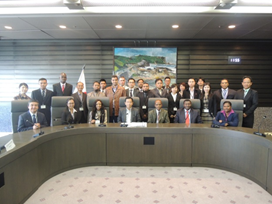 Trainees of the JPO/IPR Training Course for FY2014
Trainees of the JPO/IPR Training Course for FY2014 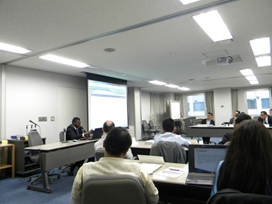 Trainees of the JPO/IPR Training Course for FY2014
Trainees of the JPO/IPR Training Course for FY2014
[Japan International Cooperation Agency] [Tuesday, Nov 18, 2014]
Successful Philippine Economic Briefing Contributed by JICA
The Government of the Philippines held a Philippine Economic Briefing (Forum) in Tokyo on October 8, 2014. Headed by Cesar V. Purisima, secretary of finance, the Philippine Delegation comprised secretaries and high-ranking officials of the Department of Finance, the National Economic and Development Authority (NEDA), the Department of Public Works and Highways (DPWH), the Department of Tourism (DOT), the Department of Transportation and Communications (DOTC), and the Department of Energy (DOE), among others.
The forum, titled “Sustaining Inclusive Growth through Infrastructure and Capital Market Development,” aimed to promote investment in the Philippines’ financial and infrastructure sectors, and was attended by nearly 400 attendees from various companies, mostly belonging to the financial and construction sectors. The significant number of attendees is a testament of the growing interest of Japanese investors in the Philippines.
The Philippines has become a “VIP”
It has been more than 10 years since Goldman Sachs announced the BRICs (Brazil, Russia, India, and China) as fast-growing economies. Nikkei BP named the VIPs (Vietnam, Indonesia, and the Philippines) as the next drivers of global economic growth. It is said that the VIPs will most likely surpass the BRICs’ average GDP growth rate 20 to 30 years from now. The newly formed middle class (defined as a household with a disposal income/year exceeding 5,000 USD) will be around 59 million in Vietnam, 217 million in Indonesia, and 73 million in the Philippines by 2020.
The Philippines has been recently projecting a favorable image to investors in Japan. Although the Philippines was once regarded as a lagging ASEAN member, it has now become one of the fastest growing economies in the region. In 2013, the Philippines gained investment-grade sovereign credit ratings from major rating agencies. The fact that the forum attracted more than 400 people shows the vast interest in investing in the Philippines. It is clear that the Philippines is now regarded as a “VIP” in Japan, in both senses of the word. Speaking to the Japanese people, Secretary Purisima said, “The Philippines would like to be a partner to Japan as Mexico is to the U.S.A. ... When you look south, the Philippines will be looking north. And hopefully we can meet in between.”
JICA supported the Government of the Philippines in organizing this forum and also provided speakers for the event. Hidetoshi Irigaki, director general of JICA Southeast Asia and the Pacific Department made a presentation titled “Outlook on the Philippines’ Infrastructure Sector,” while Megumi Muto, deputy director general from the same department participated in panel discussions at the event. As the Philippine Delegation presented their plans for infrastructure investment, Irigaki explained from a development institution standpoint, the role of JICA as a solution provider at both the policy and project levels. Four areas for potential collaboration between the Philippines and Japan were highlighted, namely: (1) developing a sustainable transport network in Mega Manila, (2) increasing disaster resilience, (3) increasing energy efficiency, and (4) maximizing Value-for-Money through public-private partnerships.
With the vision of introducing valuable information from Japanese experience, policy, technology, and know-how as a solution provider, JICA provided special support to the Philippine Delegation to arrange site visits to infrastructure project sites relevant to the challenges that the Philippines is currently facing in the areas of transportation, disaster risk reduction, and energy efficiency.
Introducing Japan’s large-scale infrastructure experience
Ramon R. Jimenez, secretary of tourism, Rene K. Limcaoco, undersecretary of the DOTC, and Cosette V. Canilao, executive director of the Public-Private Partnership Center visited Haneda Airport and Keikyu Kamata Station. At Haneda Airport, they toured the D-runway, the fourth and newest runway constructed on a hybrid structure combining a reclaimed island and piled-elevated platform. The DOTC is envisioning reclamation of the Manila waterfront area to develop a new international airport that will serve the country’s national capital region. At Keikyu Kamata Station, they observed the recently renovated station structure after a decade-long project to elevate the original ground-level tracks to provide additional track capacity and eliminate road congestion at the crossings, which is expected to serve as reference for the DOTC’s flagship railway project, North-South Commuter Rail, since similar road and railway coordination is required. The delegation showed great interest at both sites, particularly on the public-private coordination mechanism utilized in the Japanese projects.
Further enhancing disaster resilience capacity
Rogelio L. Singson, secretary of the DPWH, and Rafael C. Yabut, undersecretary of the DPWH, visited the Koto Flood Control Office of the Tokyo Metropolitan Government Flood Gate Management Center, Ohgibashi Lock Gate, and the River Channel Improvement of Kyu-Nakagawa River, which manages the lowland river area called the Koto Triangles Area between two major rivers in Tokyo, the Sumida River and the Arakawa River. The visit introduced experience on how the Government of Japan and the Tokyo Metropolitan Government undertake river management and flood control projects to enhance disaster resilience, which is a common goal in Philippine contexts.
Promoting energy investment
Raul B. Aguilos, undersecretary of the DOE, and Guillermo M. Luz, chairperson of the National Competitive Council, visited Haneda Airport and Kawasaki Industrial Park, where Ajinomoto Co., Inc., and Kao Corporation are located. The theme of the site visit was to showcase various utilization options and the merits of natural gas, since the Government of the Philippines is currently considering commencing its first natural gas pipeline project. After the tour, Aguilos said, “We learned that natural gas is not only for the power plants, but is one of the core facilities for public transportation such as airports and industrial parks, and we hope that introducing the Batman 1 pipeline [Batangas – the Manila Natural Gas Pipeline Project] will attract further investment in the Philippines in various sectors and improve energy efficiency.”
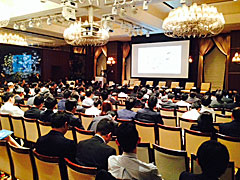 Nearly 400 attendees fill the venue.
Nearly 400 attendees fill the venue. 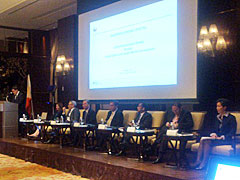 Megumi Muto, right, deputy director general of JICA Southeast Asia and the Pacific Department appeas a panelist.
Megumi Muto, right, deputy director general of JICA Southeast Asia and the Pacific Department appeas a panelist. 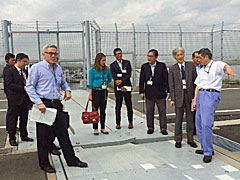 Rene K. Limcaoco, undersecretary of the Department of Transportation and Communications, frot left, and other senior officials toured the D-runway, the fourth and newest runway of Haneda airport.
Rene K. Limcaoco, undersecretary of the Department of Transportation and Communications, frot left, and other senior officials toured the D-runway, the fourth and newest runway of Haneda airport. 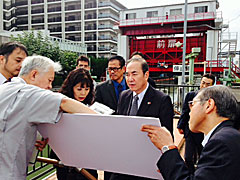 Rogelio L. Singson, secretary of the Department of Public Works and Highways, second from right, and other senior officials listen to an explanation at Ohgibashi Lock Gate.
Rogelio L. Singson, secretary of the Department of Public Works and Highways, second from right, and other senior officials listen to an explanation at Ohgibashi Lock Gate. 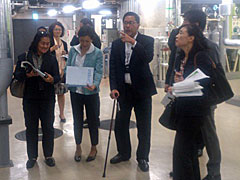 M. Luz, chairperson of the National Competitive Council, third from left, and other senior officials listen to an explanation at Haneda airport.
M. Luz, chairperson of the National Competitive Council, third from left, and other senior officials listen to an explanation at Haneda airport.